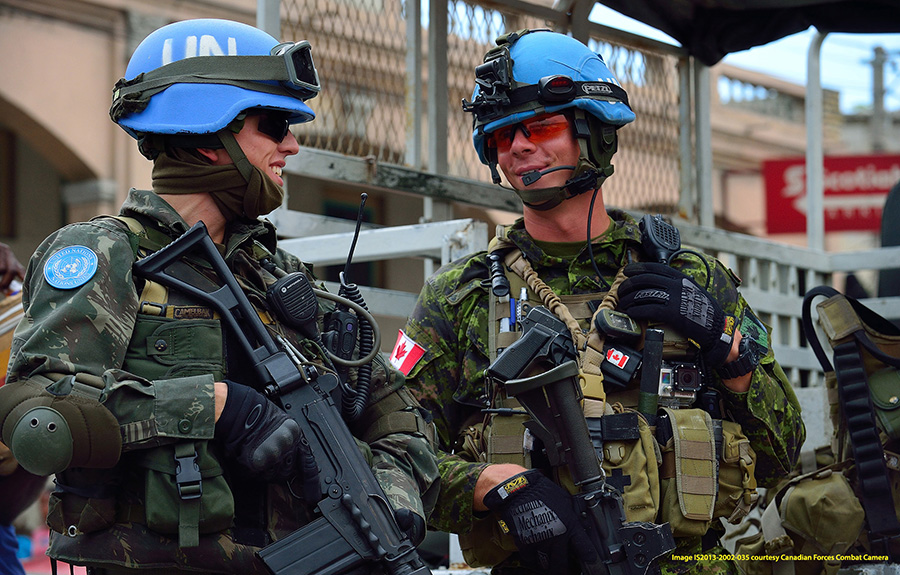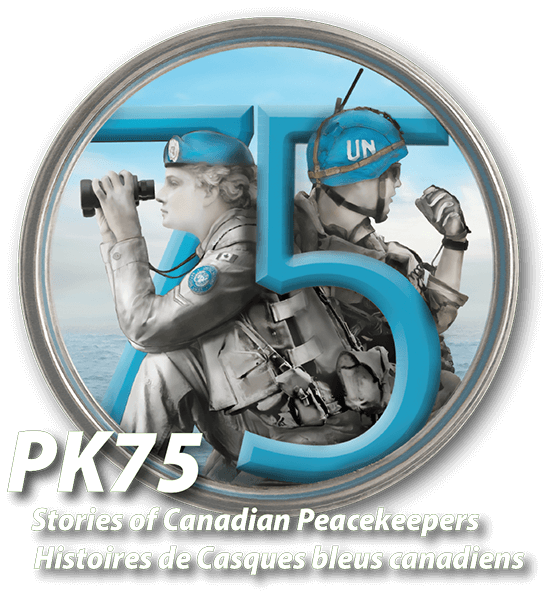
Canada and UN Peacekeeping: From Leader to Reluctant Spectator
Introduction
Canada's engagement in UN-authorized peacekeeping missions since the creation of the international organization in 1945 has become part of a national mythology and constitutes a broadly-based and deep-seated belief, held at least amongst 'older generations' of Canadians, that peacekeeping is part of Canada's national identity as a global good citizen. However, since the turn of the millennium, that engagement has become more about our history than our present. This article reflects on the history, while noting the rapid decline since the latter half of the 1990s, and subsequent governments' rejection or reluctance to re-engage with peacekeeping.
From 'Golden Age' to Pivot Away from Peacekeeping
On 7 November 1956, the United Nations General Assembly passed Resolution A/RES/1001(ES-I) authorizing the Secretary-General to establish a peacekeeping force to send to the Suez Canal, where it would replace the Israeli, British and French military forces that had invaded Egypt in response to President Gamal Abdel Nasser's announcement in late July of the nationalization of the Suez Canal Company. The Force Commander of the newly established United Nations Emergency Force (UNEF) would be a Canadian — Major-General E. L. M. ('Tommy') Burns, then serving as Chief of Staff of the UN Truce Supervision Organization (UNTSO). Canada also agreed to provide a contingent of troops to UNEF for its supply and logistics functions.
The popular notion of Canada as a UN peacekeeper came to the fore with this so-called 'Suez crisis' and Secretary of State for External Affairs Lester B. Pearson's proposal to the UN Secretary-General and the member states of the General Assembly for the creation of a new, armed intermediary force - the beginning of UN peacekeeping. For his efforts in promoting the peaceful resolution of the Suez crisis, Pearson was awarded the 1957 Nobel Peace Prize.
In fact, Canada's history of engagement with UN peace missions, as the mention of Tommy Burns and UNTSO suggests, predated 1956 and Suez by almost a decade. The UN Truce Supervision Organization was established in May 1948, meaning that 2023 marks the 75th anniversary of UN peacekeeping. In addition to UNTSO, Canadian military personnel serving as unarmed observers had been part of the UN Temporary Commission on Korea in 1947, and the UN Military Observer Group in India and Kashmir, established in 1949 — the latter marred by the death of Brigadier-General Harry Angle in a plane crash in the Himalayas, the highest-ranking Canadian soldier to be killed in a UN peace operation.
After 1956, and through the Cold War years into the early 1990s, Canada remained a steadfast troop contributor to UN peacekeeping operations. By the time the Nobel Peace Prize was awarded to UN peacekeepers in 1988, Canada had provided approximately 80,000 out of the total of 800,000 'blue helmets' who had served in UN peacekeeping missions around the world. Canada thus provided 10 percent of all peacekeepers deployed during those decades, in diverse locations including Lebanon, Yemen, Palestine, Cyprus, Congo, Namibia, West New Guinea, India-Pakistan, Kashmir, Afghanistan, Iran-Iraq, and (in the early 1990s) in Central America, El Salvador, Cambodia, and on the Iraq-Kuwait border with UNIKOM following the 1990–1991 Gulf War.
The end of the Cold War saw rapid growth in the number of UN peacekeeping operations, with sixteen new missions being established during 1989–1993 — as many as had been authorized during the previous forty years. 1993 saw the peak (in numerical terms) of Canadian commitments, with 3,300 Canadian uniformed personnel engaged in United Nations operations. However, following several UN peacekeeping missions in the first half of the 1990s — in Somalia, Croatia and then Bosnia, and Rwanda — which ended with disasters, the scale and scope of UN peacekeeping shrank significantly. Canadian military contributions to UN peacekeeping followed suit, for domestic economic and political reasons as much as being in direct response to those disasters. By the end of the decade (and millennium), Canada's contribution to UN peacekeeping was limited to 250 uniformed personnel, with the majority — almost 200 — of these being logisticians serving with UNDOF, the observer mission in the Golan Heights. That commitment (called Op DANACA for the Canadian Forces) would be reduced to four, and then to two, Canadian uniformed personnel serving in staff positions by 2006.
More positively, Canada did provide the force commander for the UN Transitional Mission in Haiti in 1997, and for the UN Disengagement Observer Force (UNDOF) in 1999–2000. Canada also partnered with the Netherlands and several other countries in 1996 to establish the Standby High Readiness Brigade for UN Peace Operations (SHIRBRIG). In that latter context, Canada provided a Canadian Forces mechanized infantry company along with engineers and logisticians to the UN Mission in Ethiopia and Eritrea (UNMEE) for a six-month rotation in 2000–2001, and DND also later provided a SHIRBRIG Brigade Commander who served as the Senior Military Advisor in the UN Advance Mission in Sudan (UNAMIS), and as Deputy Force Commander in the UN Mission in Sudan (UNMIS), although the staffing support provided by Canada for this initiative remained small.
A pivot away from engagement in UN peacekeeping and towards NATO operations could be seen already in 1999, in Canada's support for — and leadership in — conducting the NATO-led (and without UN Security Council authorization) bombing campaign against Serbia during the Kosovo crisis; and subsequently in Canadian Forces participation in the NATO-led Kosovo Force (KFOR), even though the latter took place under the auspices of a UN operation, UNMIK. Then, following the terrorist attacks of 11 September 2001 against the United States, the Canadian Forces were committed increasingly to warfighting with its NATO allies in Afghanistan, rather than peacekeeping through the UN. Between 2001 and the withdrawal of Canadian Forces from combat operations in 2014, the war cost 165 Canadian military and civilian fatalities, approximately 2,000 wounded or otherwise physically injured, and left numerous other Canadian veterans suffering from post-traumatic stress disorder — with more than 70 suicides amongst veterans subsequently reported as related to serving in Afghanistan — as well as costing between $10 billion and $18 billion.
Canada's rank as a contributor of uniformed personnel to UN peacekeeping fell to 70th out of 120 'troop contributing states' (TCCs). In 2011, Canada did contribute to the UN Security Council-authorized, U.S.- and NATO-led air and maritime operations against the Libyan regime of Moammar Gadhafi. Canadian CF-18s flew numerous combat sorties against Gadhafi's forces, and a Canadian frigate conducted maritime patrols enforcing an arms embargo.
Canada and Peacekeeping Today: Hesitant, Limited, and Uncertain
Rhetorical announcements in 2015 of Canada being 'back' as an active multilateralist raised expectations at home, and also internationally, that Canada might maintain its existing NATO commitments — with several hundred Canadian troops based in Ukraine and Latvia supporting those states against Russian aggression, and in Iraq assisting with training Iraqi government forces and conducting operations against ISIS — while providing additional resources to UN peacekeeping operations. In mid-2016 the new government announced that Canada would provide 'up to' 750 personnel (600 uniformed and 150 civilian) to UN peace operations, presumably in addition to existing personnel. In March 2018, the government announced Canada's commitment: an air task force deployment to provide tactical transport and medical evacuation support to the UN Mission in Mali (MINUSMA), consisting of the provision of eight helicopters and a total of 250 Canadian Armed Forces (CAF) members for a one-year deployment.
As Walter Dorn informs in his regularly updated "Tracking the Promises" website report, as of June 2021 Canada had never deployed more than 300 of the "up to" 750 (or 862) uniformed personnel, and that higher figure included the 250 CAF personnel of the Mali mission as a one-time deployment. In fact, with that exception aside, the number of Canadian uniformed personnel who contributed to UN peacekeeping was at a historic record low. On a positive note, Canada contributes 2.7% of the UN peacekeeping budget — making it the 9th largest financial contributor to that budget — and consistently pays its UN assessed dues on time, in full, and without conditions. Overall, however, Dorn concludes that "the rhetoric remains lofty on paper and in speeches, but the Canadian government has yet to match its words with deeds."


